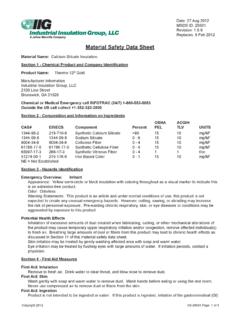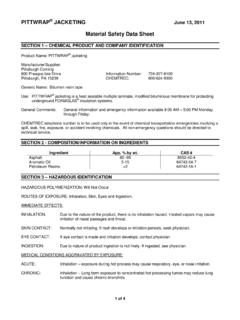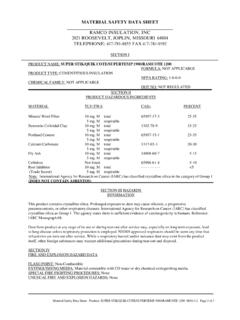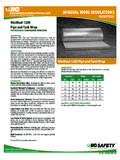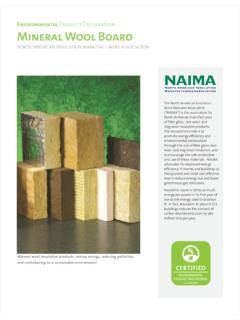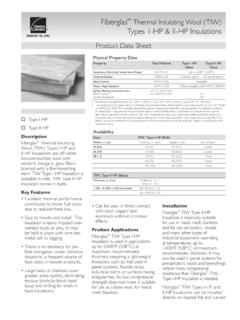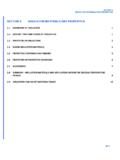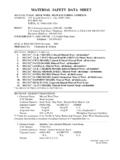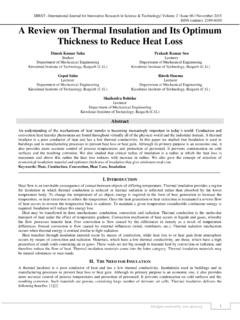Transcription of Thermal Ceramics - ACME INSULATIONS
1 Page 1 Of 9 Thermal Ceramics MATERIAL SAFETY DATA SHEETMATERIAL SAFETY DATA SHEETMATERIAL SAFETY DATA SHEETMATERIAL SAFETY DATA SHEET MSDS No: 201 Date Prepared: 10/01/1985 Current Date: 5/16/2007 Last Revised: (05/16/2007) 1. CHEMICAL PRODUCT AND COMPANY IDENTIFICATION Product Group: REFRACTORY ceramic FIBER PRODUCT Chemical Name: VITREOUS ALUMINOSILICATE FIBER Synonyms: RCF, ceramic fiber, synthetic vitreous fiber (SVF), man-made vitreous fiber (MMVF), man-made mineral fiber (MMMF) Trade Names: Kaowool ; Cerafiber ; Cerachem ; Uni-Bloc ; Saber-Bloc ; Quad-Bloc ; Pyro-Fold ; Ultrafelt ; Pyro-Blanket ; Pyro-Log ; Cerablanket ; Z-Blok ; Isoblanket ; Pyro-Bloc : Blanket, Modules, Strips, Bulk, Packing, insulation , Shapes, Rope, Engineered Fiber, Heat Treated Blanket (all grades), Kaowool RT Cer-Wool HP, HTZ, HTA, Utility: Blanket, Bulk Cer-Wool RT: Blanket, Bulk PREFLEX HP, HTZ Module PREMAX HP, HTZ, HTA Module MONOMAX Modules, Blanket Manufacturer/Supplier: Thermal Ceramics Inc.
2 P. O. Box 923; Dept. 300 Augusta, GA 30903-0923 For Product Stewardship and Emergency Information - Hotline: 1-800-722-5681 Fax: 706-560-4054 For additional MSDSs and to confirm this is the most current MSDS for the product, visit our web page [ ]. 2. COMPOSITION / INFORMATION ON INGREDIENTS COMPONENTS CAS NUMBER % BY WEIGHT Refractories, Fibers, Aluminosilicate 142844-00-6 40 - 100 Water 7732-18-5 0 - 60 (See Section 8 "Exposure Controls / Personal Protection" for exposure guidelines) 3. HAZARDS IDENTIFICATION EMERGENCY OVERVIEW WARNING! POSSIBLE CANCER HAZARD BY INHALATION. (See Section 11 for more information) MSDS No: 201 Date Prepared: 10/01/1985 Current Date: 5/16/2007 Last Revised: (05/16/2007) Page 2 Of 9 CHRONIC EFFECT There has been no increased incidence of respiratory disease in studies examining occupationally exposed workers. In animal studies, long term laboratory exposure to doses hundreds of times higher than normal occupational exposures has produced fibrosis, lung cancer and mesothelioma in rats or hamsters.
3 The fibers used in those studies were specially sized to maximize rodent respirability. OTHER POTENTIAL EFFECTS TARGET ORGANS: Respiratory Tract (nose and throat), Eyes, Skin RESPIRATORY TRACT (nose and throat) IRRITATION: If inhaled in sufficient quantity, may cause temporary, mild mechanical irritation to respiratory tract. Symptoms may include scratchiness of the nose or throat, cough or chest discomfort. EYE IRRITATION: May cause temporary, mild mechanical irritation. Fibers may be abrasive; prolonged contact may cause damage to the outer surface of the eye. SKIN IRRITATION: May cause temporary, mild mechanical irritation. Exposure may also result in inflammation, rash or itching. GASTROINTESTINAL IRRITATION: Unlikely route of exposure. MEDICAL CONDITIONS AGGRAVATED BY EXPOSURE: Pre-existing medical conditions, including dermatitis, asthma or chronic lung disease may be aggravated by exposure; individuals who have a history of allergies may experience greater amounts of skin and respiratory irritation.
4 HAZARD CLASSIFICATION Although studies, involving occupationally exposed workers, have not identified any increased incidence of respiratory disease, results from animal testing have been used as the basis for hazard classification. In each of the following cases, the conclusions are qualitative only and do not rest upon any quantitative analysis suggesting that the hazard actually may occur at current occupational exposure levels. The International Agency for Research on Cancer (IARC) confirmed in October 2001 that Group 2B (possible human carcinogen based on sufficient evidence of carcinogenicity in animals but inadequate evidence in humans) continues to be the appropriate classification for refractory ceramic fiber. The Seventh Annual Report on Carcinogens (1994), prepared by the National Toxicology Program (NTP), classified respirable RCF and glasswool as substances reasonably anticipated to be carcinogens. The American Conference of Governmental Industrial Hygienists (ACGIH) has classified RCF as A2-Suspected Human Carcinogen.
5 The Commission of The European Communities (DG XI) has classified RCF as a substance "that should be regarded as if it is carcinogenic to man." The State of California, pursuant to Proposition 65, The Safe Drinking Water and Toxic Enforcement Act of 1986, has listed " ceramic fibers (airborne fibers of respirable size)" as a chemical known to the State of California to cause cancer. The Canadian Environmental Protection Agency (CEPA) has classified RCF as "probably carcinogenic" (Group 2). The Canadian Workplace Hazardous Materials Information System (WHMIS) RCF is classified as Class D2A - Materials Causing Other Toxic Effects. The Hazardous Materials Identification System (HMIS) Health 1* Flammability 0 Reactivity 0 Personal Protection Index: X (Employer Determined) (* denotes potential for chronic effects) MSDS No: 201 Date Prepared: 10/01/1985 Current Date: 5/16/2007 Last Revised: (05/16/2007) Page 3 Of 9 4. FIRST AID MEASURES RESPIRATORY TRACT (nose and throat) IRRITATION: If respiratory tract irritation develops, move the person to a dust free location.
6 See Section 8 for additional measures to reduce or eliminate exposure. EYE IRRITATION: If eyes become irritated, flush immediately with large amounts of lukewarm water for at least 15 minutes. Eyelids should be held away from the eyeball to ensure thorough rinsing. Do not rub eyes. SKIN IRRITATION: If skin becomes irritated, remove soiled clothing. Do not rub or scratch exposed skin. Wash area of contact thoroughly with soap and water. Using a skin cream or lotion after washing may be helpful. GASTROINTESTINAL IRRITATION: If gastrointestinal tract irritation develops, move the person to a dust free environment. - If the above symptoms persist, seek medical attention. - NOTES TO PHYSICIANS: Skin and respiratory effects are the result of temporary, mild mechanical irritation; fiber exposure does not result in allergic manifestations. 5. FIRE FIGHTING MEASURES NFPA Codes: Flammability: 0 Health: 1 Reactivity: 0 Special: 0 NFPA Unusual Hazards: None Flammable Properties: None Flash Point: None Hazardous Decomposition Products: None Unusual Fire and Explosion Hazard: None Extinguishing Media: Use extinguishing media suitable for type of surrounding fire 6.
7 ACCIDENTAL RELEASE MEASURES SPILL PROCEDURES Avoid creating airborne dust. Dust suppressing cleaning methods such as wet sweeping or vacuuming should be used to clean the work area. If vacuuming, the vacuum should be equipped with a HEPA filter. Compressed air or dry sweeping should not be used for cleaning. 7. HANDLING AND STORAGE STORAGE Store in original container in a dry area. Keep container closed when not in use. HANDLING Handle ceramic fiber carefully. Limit use of power tools unless in conjunction with local exhaust. Use hand tools whenever possible. Frequently clean the work area with HEPA filtered vacuum or wet sweeping to minimize the accumulation of debris. Do not use compressed air for clean-up. EMPTY CONTAINERS Product packaging may contain residue. Do not reuse. MSDS No: 201 Date Prepared: 10/01/1985 Current Date: 5/16/2007 Last Revised: (05/16/2007) Page 4 Of 9 8. EXPOSURE CONTROLS/PERSONAL PROTECTION EXPOSURE GUIDELINES MAJOR COMPONENT OSHA PEL MANUFACTURER S REG.
8 Refractories, Fibers, Aluminosilicate None Established* f/cc, 8-hr. TWA** * There is no specific regulatory standard for RCF in the OSHA s Particulate Not Otherwise Regulated (PNOR) standard [29 CFR , Subpart Z, Air Contaminants] applies generally - Total Dust 15 mg/m3; Respirable Fraction 5 mg/m3. ** The Refractory ceramic Fibers Coalition (RCFC) has sponsored comprehensive toxicology and epidemiology studies to identify potential RCF-related health effects [see Section 11 for more details], consulted experts familiar with fiber and particle science, conducted a thorough review of the RCF-related scientific literature, and further evaluated the data in a state-of-the-art quantitative risk assessment. Based on these efforts and in the absence of an OSHA PEL, RCFC has adopted a recommended exposure guideline (REG), as measured under NIOSH Method 7400 B. The manufacturers REG is intended to promote occupational health and safety through feasible exposure controls and reductions as determined by extensive industrial hygiene monitoring efforts undertaken voluntarily and pursuant to an agreement with the Environmental Protection Agency.
9 OTHER OCCUPATIONAL EXPOSURE LEVELS (OEL) RCF-related occupational exposure limits vary internationally. Regulatory OEL examples include: Australia f/cc; Austria f/cc; Canada to f/cc; Denmark f/cc; France f/cc; Germany f/cc ( f/cc for new installations); Netherlands f/cc; New Zealand f/cc; Norway f/cc; Poland f/cc; Sweden f/cc; United Kingdom f/cc. Non-regulatory OEL examples include: ACGIH TLV f/cc; RCFC REG f/cc. The objectives and criteria underlying each of these OEL decisions also vary. The evaluation of occupational exposure limits and their relative applicability to the workplace is best performed, on a case-by-case basis, by a qualified Industrial Hygienist. ENGINEERING CONTROLS Use feasible engineering controls such as local exhaust ventilation, point of generation dust collection, down draft work stations, emission controlling tool designs, and materials handling equipment designed to minimize airborne fiber emissions.
10 PERSONAL PROTECTION EQUIPMENT Respiratory Protection RCF: When engineering and/or administrative controls are insufficient to maintain workplace exposures within the f/cc REG, the use of appropriate respiratory protection, pursuant to the requirements of OSHA Standards 29 CFR and 29 CFR , is recommended. The following information is provided as an example of appropriate respiratory protection for aluminosilicate fibers. The evaluation of workplace hazards and the identification of appropriate respiratory protection is best performed, on a case-by-case basis, by a qualified Industrial Hygienist. MANUFACTURER S RESPIRATORY PROTECTION RECOMMENDATIONS WHEN HANDLING RCF PRODUCTS Respirable Airborne Fiber Concentration Respirator Recommendation 1111 Not yet determined but expected to be below f/cc based on operation Half-face, air-purifying respirator equipped with a NIOSH-certified P100 particulate filter cartridge. "Reliably" less than f/cc See recommendation below for individual worker requests.

